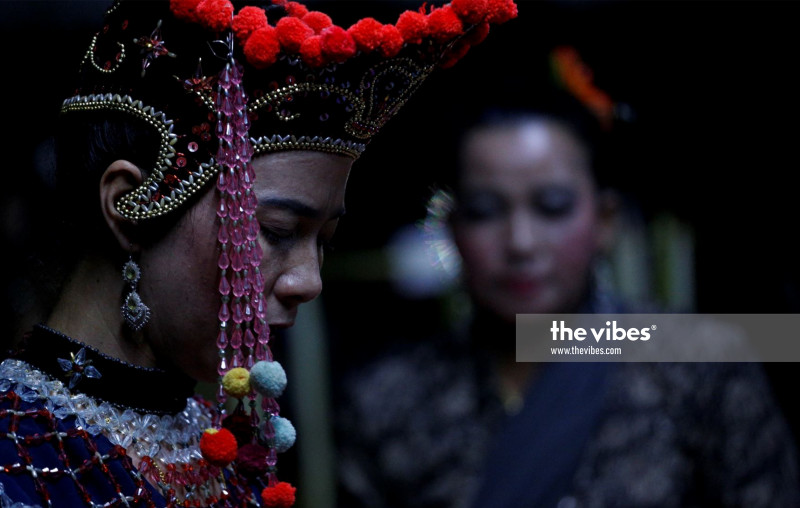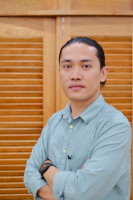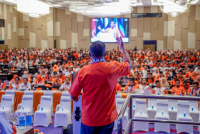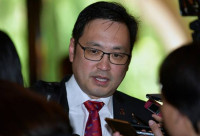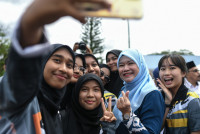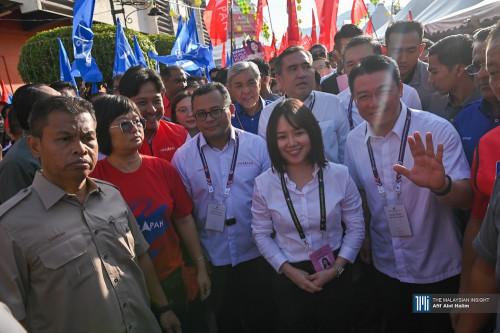IT was 6 o’clock. As the sun descended, it stained the sky with deep shades of orange and yellow. Only a few rays of light cut through the dark forest, reaching the backyard of the Kelantan-styled wooden house located at the edge of Kampung Gong Lapang, in Kuala Besut.
Che Siti Dollah, affectionately known as Mek Ti, was sitting crossed-legged at the front veranda, overseeing the final preparations at the open-air panggung — a makeshift theatre-in-the-round. Only two men remained. All that was left to be done now was to mark the border by tying two lines of raffia rope horizontally, connecting the four pillars. Lastly, they decorated the borders with flowers and coconut palm fronds. The panggung was now ready for the Mak Yong ritual performance that was about to take place.
Mek Ti was silent and calm, trusting the two men experienced in their craft. Behind her, a group of women dancers in black kebaya gathered in the cramped living room to do their makeup. Mek Ti is one of the few remaining veteran Mak Yong actresses in Kelantan and its border areas. Now in her 80s, with deteriorating vision and fragile knees, she is only able to sit in the panggung and do what she describes as menjawab nyanyian (answering the song).
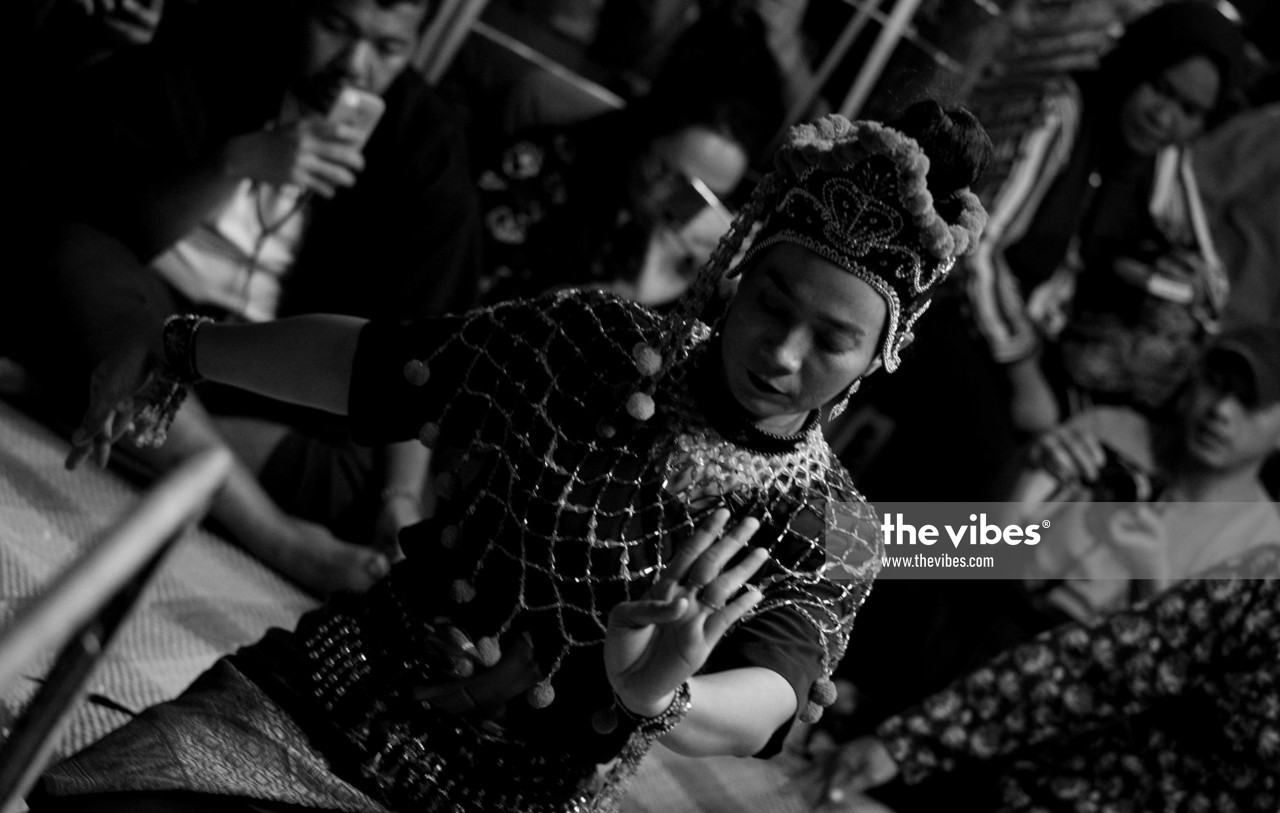
Mek Ti is the main custodian of Mak Yong in her community. She leads the Cahaya Matahari troupe, a Mak Yong group founded by the late Che Ning, a legendary Mak Yong prima donna in Kelantan. Ensuring the continuity of the Mak Yong tradition is Mek Ti’s niece and Che Ning’s granddaughter, Rohana Abdul Kadir, who plays the principal role, alongside her sisters, her father Pak Su Kadir and other seasoned Mak Yong performers.
For Mek Ti, making conversation with the guests and exchanging banter with the musicians was not only to break the silence. It distracted her from thinking about the unanticipated news she had received a week earlier.
Her original plan to hold the event at her own place near Kuala Besut had been rejected by the village headman, forcing the troupe to find refuge in another village. This time, the ritual performance had to be done discreetly at her relative’s house, far below the radar of the authorities.
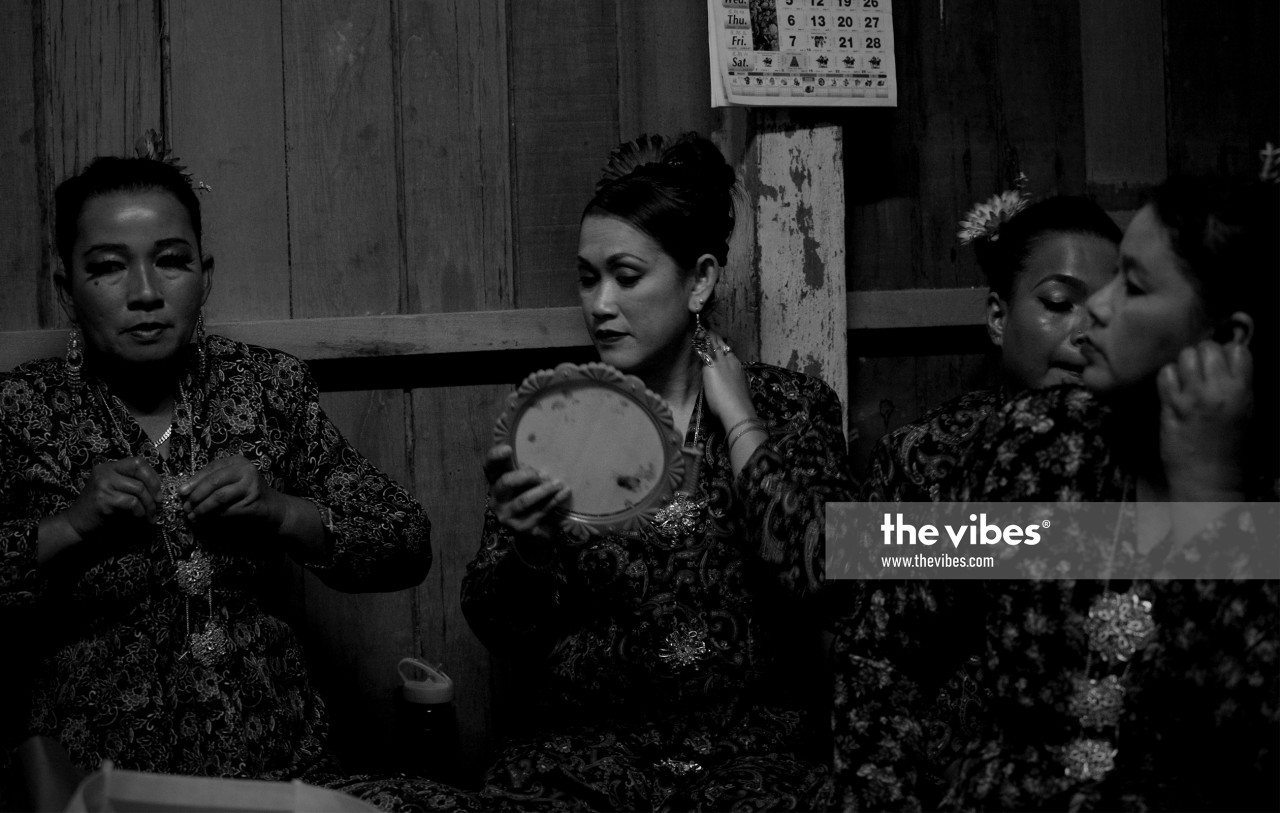
The village headman’s refusal to allow a Mak Yong performance came in the wake of the Terengganu state government’s announcement of new guidelines on culture and entertainment, guidelines that include strict prohibitions on women performers and gender segregation even for the audience.
Having witnessed nearly three decades of censorship of the traditional arts in Kelantan, just over the state border, the news felt like a ticking time bomb to Mek Ti and the whole Mak Yong community.
'Easier to practice Mak Yong under Umno'
In February 2020, I joined Pusaka, a cultural organisation led by journalist and culturalist, Eddin Khoo, to Kuala Besut to experience a Mak Yong ritual performance in its community setting and to grapple with the cultural politics that surrounds it.
Pusaka had organised a three-day Mak Yong cultural immersion for selected writers, researchers, filmmakers, and theatre practitioners, with the support of Malaysian Reform Initiative (Mari), the US Embassy, and USAID.
Like other border districts of Kelantan, Kuala Besut is regarded as part of the cradle of Kelantanese Malay heritage. Although it falls under the administration of Terengganu, Kuala Besut shares many commonalities with Kelantan culturally, in particular the food, dialect, and artistic traditions.
Being politically under Terengganu — a stronghold state of the dominant Malay political party, United Malays National Organisation (Umno) — had been an advantage to traditional performers like Mek Ti. Kuala Besut sat somewhat removed from the Pan-Malaysian Islamic Party (PAS) power centre in Kelantan, and people enjoyed freedoms deemed incongruent with PAS’s Islamic way of life.
This relative liberty ended in May 2018, when Terengganu fell under PAS’ control in Malaysia’s historic 14th General Election. PAS’ Islamic ideological impositions and cultural restrictions in Kelantan have now spilled beyond Kelantan’s political border. “It was easier to practice Mak Yong under Umno," Mek Ti told me.
I sat with Mek Ti in the panggung while we waited for Pak Su Agel, a master gendang player and one of the most accomplished musicians in Kelantan, to set up his ensemble. “They appreciated Mak Yong and didn’t restrict us here. But now… things have changed," she conveyed. Today, Mek Ti and the Mak Yong Cahaya Matahari group must deal with an ever-growing Islamic influence from both Kelantan and Terengganu.
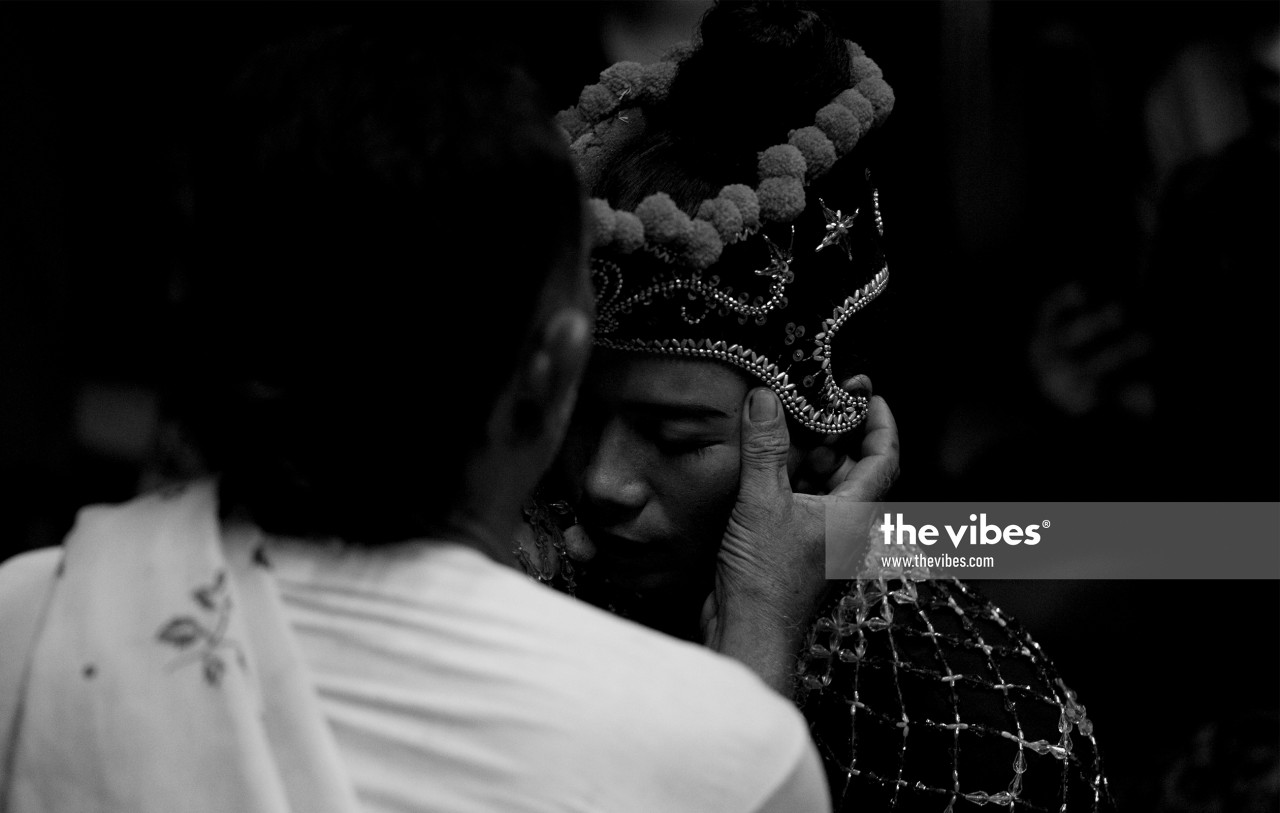
Mak Yong is a traditional Malay dance-drama and healing ritual primarily found in Kelantan as well as the Pattani region of southern Thailand. Mak Yong is believed to have existed as a ritual art for centuries and, for a period until the 1920s, enjoyed the royal patronage of the Kelantan Sultanate.
After Independence, into the 1970s and 80s, itinerant Mak Yong troupes came to prominence, led by ‘prima donnas’ like Che Ning. However, the changing political winds set their ideological weapons against traditional culture.
Soon after their rise to political power in Kelantan in 1990, PAS proscribed Mak Yong and several other traditional art forms, citing ‘animist and Hindu-Buddhist roots which pre-date Islam’ and painting them as ‘immoral’ activities that contain elements of shirk (polytheism) and khurafat (superstition).
Despite the damaging proscription by PAS, Mak Yong was recognised by Unesco in 2005 as a ‘Masterpiece of Intangible and Oral Heritage of Humanity’. A masterpiece banned in its place of origins.
(VIDEO) Angin Keturunan — Pusaka documents a ritual ‘semah angin’ performance by Kumpulan Mak Yong Cahaya Matahari, in Kuala Besut, Terengganu. Film directed by Aidyl Abadi and Persona Theory.
A Mak Yong performance usually begins by paying respect to the "original teacher" (guru asal) with an offering. This ceremony is known as the buka panggung (consecration of the stage). This is followed by a delicate opening dance performed by a group of eight to 10 women called menghadap rebab (salutations to the rebab).
The performance continues with the enactment of stories derived mainly from Kelantan-Pattani mythology, with refined and stylised dialogue. Another important element in Mak Yong is the music ensemble, featuring instruments such as rebab (three-stringed spiked fiddle), gendang (double-headed drum), a pair of gongs, serunai (Malay oboe), geduk drums and kesi (small cymbals).
More than just a dance-drama, Mak Yong as practiced by Mek Ti is a form of psychotherapy — a healing ritual that involves communication with spirits, ancestors and the "original teacher" but most of all the release of suppressed angin (inner winds) of the individual psyche.
“People easily condemn Mak Yong as sinful when they don’t understand its essence and origin,” said Mek Ti. She holds that there is no contradiction between being a devout Muslim and practising Mak Yong.
Mak Yong is a marker of the community’s roots and history, reminding them of their deep heritage and identity.
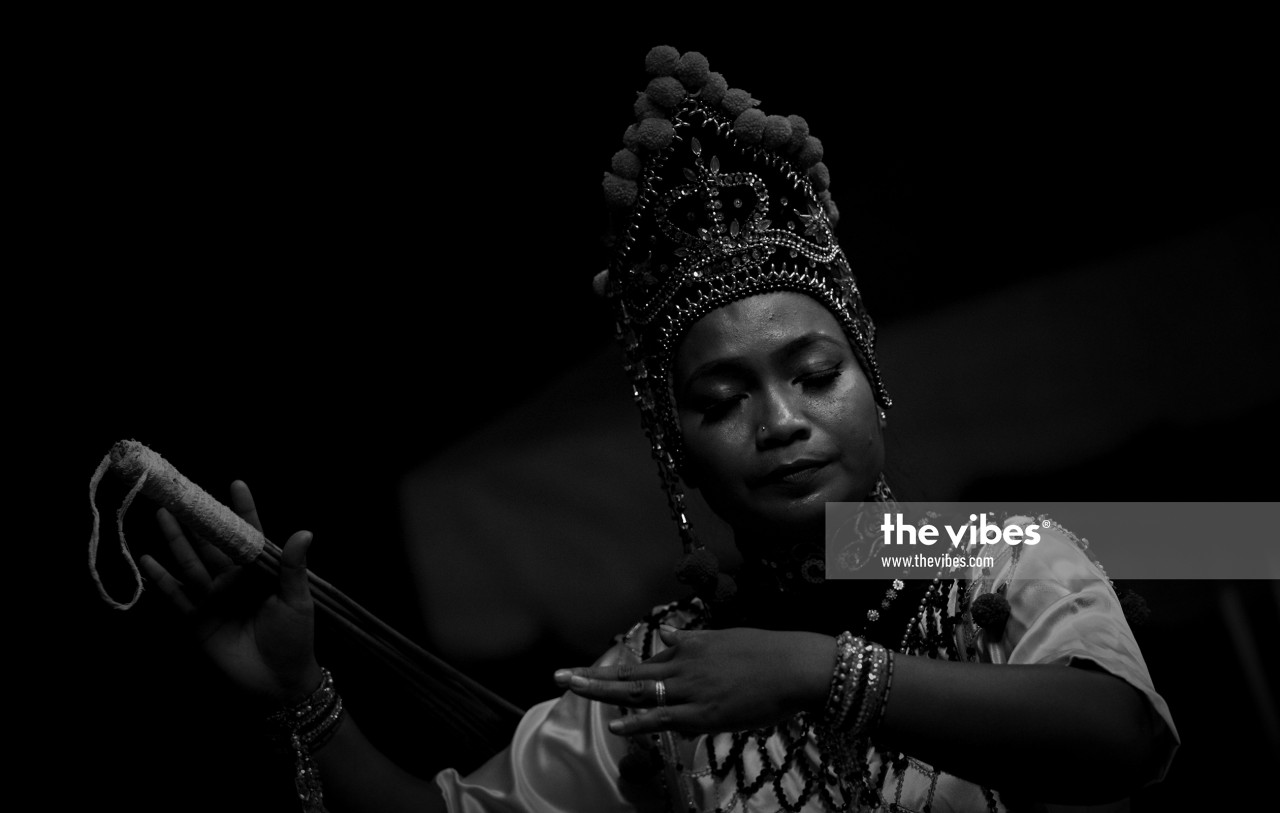
Mek Ti sees the women centred Mak Yong tradition as a legacy left by Che Siti Wan Kembang, the legendary queen of Kelantan who reigned in the 16th century, and an emblem of the powerful position of women in Kelantan. Mak Yong immortalises traces of love and desire, war and truce, the alliances and enmity of kings, the lives of archetypal characters of past kingdoms. It also serves as a moral compass and provides a sense of self for Kelantanese like Mek Ti.
Cultural and religious politics in Kelantan is never as serene as the everyday life in the village. It turns some of us into fanatics, dividing people into friends and enemies or believers and kafir (infidels). As in other Malay states, politics in Kelantan is shaped by contestations between local lords, conflicts over power and influence disguised by religious and ethnic rhetoric.
To gain support that would later translate into votes, PAS positioned itself at the opposite extreme from the moderate Umno, taking on a more conservative, puritan self-image while claiming to propagate the truest version of Islam.
I spent three days in the village, immersing myself in the festivity and intensity of the mak yong performance, experiencing the wonder of the Kelantanese-Malay heritage. Yet, between the silences of the last notes of the ensemble, lies the bewildering struggle of Kelantanese cultural practitioners to keep their traditions alive amid the growing Islamic puritanism. For Mek Ti, it is better to practice the Mak Yong tradition ‘underground’ rather than let it deteriorate under PAS leadership. – The Vibes, November 7, 2020
How does Mak Yong fare underground? Look out for Part 2 in The Vibes tomorrow.



